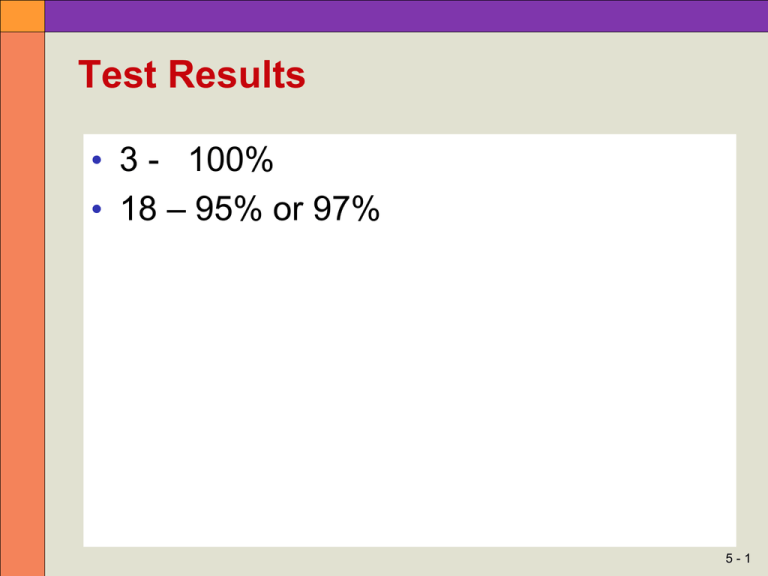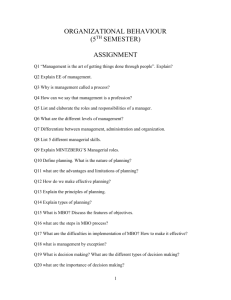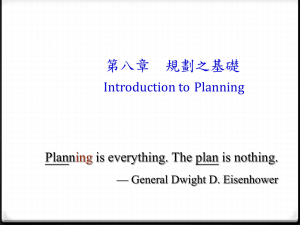
Test Results
• 3 - 100%
• 18 – 95% or 97%
5-1
Chapter Five
Planning
The Foundation of Successful
Management
McGraw-Hill/Irwin
Copyright © 2009 by The McGraw-Hill Companies, All Rights Reserved.
Major Questions You Should Be
Able to Answer
5.1 How do I tend to deal with uncertainty,
and how can planning help?
5.2 What are mission and vision
statements and what are three types of
planning and goals?
5.3 What is MBO, and how can it be
implemented and what are SMART
goals?
5-3
Major Questions You Should Be
Able to Answer
5.4 How does the planning/control cycle
help keep a manager’s plans headed in
the right direction?
5.5 What is project planning, why is it
important, and what is the project life
cycle?
5-4
Key Concepts
• Definitions:
Strategic Planning
• Levels and activities involved in
planning
• Time Frames for different levels
• +/- of planning
• Responses to uncertainty
5-5
•
•
•
•
Goals and goal setting
Types of plans
MBO process
Project Life Cycle (Activities)
5-6
Planning & Uncertainty
• Planning
coping with uncertainty by formulating
future courses of action to achieved
specified results
5-7
Planning & Strategic Management
Figure 5.1
5 -8
Why Not Plan?
1. Planning requires you to set aside the
time to do it
2. You may have to make some decisions
without a lot of time to plan
5-9
How Planning Helps You
1.
2.
3.
4.
Helps you check on your progress
Helps you coordinate activities
Helps you think ahead
Helps you cope with uncertainty
5 - 10
How Organizations Respond to
Uncertainty
• Defenders
experts at producing and selling narrowly
defined products
• Prospectors
focus on developing new products and in
seeking out new markets, rather than
waiting for things to happen
5 - 11
How Organizations Respond to
Uncertainty
• Analyzers
let other organizations take the risks of
product development and marketing and
then imitate what seems to work best
• Reactors
make adjustments only when finally forced
to by environmental pressures
5 - 12
The Adaptive Cycle
• Adaptive Cycle
businesses are continuously cycling
through decisions about three kinds of
business problems: (1) entrepreneurial, (2)
engineering, and (3) administrative
5 - 13
Making Plans
Figure 5.2
5 - 14
Mission & Vision Statements
• Mission statement
expresses the purpose of the organization
• Vision statement
expresses what the organization should
become
where it wants to go strategically
5 - 15
Example: Nest Fresh Eggs
“Nest Fresh Eggs’ mission is to remain
profitable by producing or purchasing
premium cage-free and natural eggs to
supply supermarkets and restaurants in its
markets, providing those customers with
excellent service and product and by being
an environmentally responsible corporate
citizen by using recyclable packaging and
donating to targeted charities.”
5 - 16
Three Types of Planning for Three
Levels of Management
• Strategic planning
determine what the organization’s longterm goals should be for the next 1-5 years
with the resources they expect to have
available
5 - 17
Three Types of Planning for Three
Levels of Management
• Tactical planning
determine what contributions their
departments can make during the next 624 months
5 - 18
Three Types of Planning for Three
Levels of Management
• Operational planning
how to accomplish specific tasks within the
next 1-52 weeks
5 - 19
Three Levels of Management, Three
Types of Planning
Figure 5.3
5 - 20
Goals, Action Plans, & Operating
Plans
• Goals
specific commitment to achieve a
measurable result within a stated period of
time
also known as an objective
strategic, tactical, operational
5 - 21
Goals, Action Plans, & Operating
Plans
• Action plan
defines the course of action needed to
achieve the stated goal
5 - 22
Goals, Action Plans, & Operating
Plans
• Operating plan
designed for a 1-year period
defines how you conduct your business
identifies clear targets such as revenue,
cash flow, and market share
5 - 23
Standing Plans: Policies,
Procedures, & Rules
• Policy
outlines the general response to a
designated problem or situation
• Procedure
outlines the response to a particular
problem or circumstances
• Rule
designates specific required action
5 - 24
Single Use Plans: Programs &
Projects
• Program
encompasses a range of projects or
activities
• Project
plan of less scope and complexity than a
program
5 - 25
What Is MBO?
1. Jointly set objectives
2. Develop action plan
3. Periodically review
performance
4. Give performance
appraisal and rewards,
if any
5 - 26
Cascading Objectives: MBO from
the Top Down
1.
2.
3.
4.
Top management must be committed
It must be applied organization-wide
Objectives must “cascade”
Goals negotiated
5 - 27
Setting SMART Goals
•
•
•
•
•
Specific
Measurable
Attainable
Results-oriented
Target dates
5 - 28
Example: Wal-Mart Setting
Objectives for Change
• In 2008 Wal-Mart CEO, Lee Scott, laid
out new environmental, health, and
ethical goals
• Wal-Mart would continue to promote
energy-saving in more products
• Wal-Mart would apply cost-cutting skills
to helping other companies deliver
health care for its employees
5 - 29
The Planning/Control Cycle
1. Make the plan
2. Carry out the plan
3. Control the direction by comparing
results with the plan
4. Control the direction by taking
corrective action in two ways
a. Correcting deviations
b. Improving future plans
5 - 30
The Planning/Control Cycle
Figure 5.5
5 - 31
Question?
Apple has fired employees who have
leaked news about unannounced
products. Which step of the
Planning/Control is this?
A. Make the plan
B. Carry out the plan
C. Take corrective action
D. Document the plan
5 - 32
Project Planning
• Project planning
preparation of single-use plans, or projects
5 - 33
Project Planning
• Project management
achieving a set of goals through planning,
scheduling, and maintaining progress of
the activities that
comprise the project
5 - 34
The Project Life Cycle
Figure 5.6
5 - 35
The Project Life Cycle: The
Predictable Evolution of a Project
• Stage 1: Definition
look at the big picture
state the problem
look at the assumptions and risks
identify the project’s goals and objectives
determine the budget and schedule
5 - 36
The Project Life Cycle: The
Predictable Evolution of a Project
• Stage 2: Planning
consider the details
identify the facilities and equipment
identify the people and their duties and the
schedule and coordination needed
5 - 37
The Project Life Cycle: The
Predictable Evolution of a Project
• Stage 3: Execution
actual work stage
define the management style
establish the control tools
monitor progress
prepare status
reports
5 - 38
The Project Life Cycle: The
Predictable Evolution of a Project
• Stage 4: Closing
occurs when project is accepted by the
client
can be abrupt
may be required to write a report
5 - 39
Volkswagen
• Strategic
Environment
• Issue Facing Mr.
Winterkorn
• How did his action
align with specific
theories and models
discussed in book
• Will his plan work?
5 - 40










